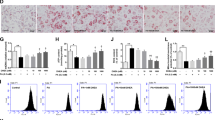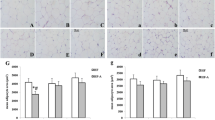Abstract
In order to clarify the effect of dehydroepiandrosterone (DHEA) on improvement of insulin resistance, we examined the effects of overexpression of wild-type protein kinase C-ζ (wt-PKCζ)/3-phosphoinositide-dependent protein kinase-1 (wt-PDK1) and kinase-inactive PKCζ/PDK1 (ΔPKCζ/ΔPDK1) on DHEA-induced [3H]2-deoxyglucose (DOG) uptake using the electroporation method in rat adipocytes. Overexpression of wt-PKCζ and wt-PDK1 significantly increased in DHEA-induced [3H]2-DOG uptake. Wortmannin completely suppressed DHEA-induced [3H]2-DOG uptake in wt-PKCζ- and wt-PDK1-transfected adipocytes. Overexpression of neither ΔPKCζ nor ΔPDK1 increased DHEA-induced [3H]2-DOG uptake. Otsuka Long-Evans fatty rats (OLETF), animal models of type 2 diabetes, and Long-Evans Tokushima rats (LETO) as control, were treated with 0.4% DHEA for 2 weeks. Insulin-induced [3H]2-DOG uptakes, activations of PI 3-kinase and PKCζ of adipocytes were significantly increased in DHEA-treated OLETF rats. Moreover, plasma glucose levels in OLETF rats after treatment with DHEA for 2 weeks were significantly lower than treatment without DHEA, but not in LETO rats. These results indicate that DHEA treatment may improve glucose tolerance through a PI 3-kinase-PKCζ pathway and downregulates adiposity in OLETF rats.





Similar content being viewed by others
References
Melby JC (1970) Assessment of adrenocortical function. N Engl J Med 285:735–739
Gordon GB, Bush DE, Weisman HF (1988) Reduction of atherosclerosis by administration of dehydroepiandrosterone. J Clin Invest 82:712–720
Yen TT, Allan JA, Pearson DV, Acton JM, Greenberg MM (1977) Prevention of obesity in Avy/a mice by dehydroepiandrosterone. Lipid 12:409–413
Coleman DL, Leiter EH, Schwizer RW (1982) Effect of genetic background on the therapeutic effects of dehydroepiandrosterone (DHEA) in diabetes-obesity mutants and aged normal mice. Diabetes 33:26–32
Ishizuka T, Kajita K, Miura A, Ishizawa M, Kanoh Y, Itaya S, Kimura M, Muto N, Mune T, Morita H, Yasuda K (1999) Dehydroepiandrosterone improves glucose uptake via activations of protein kinase C and phosphatidylinositol 3-kinase. Am J Physiol 276:E196–E204
Bandyopadhyay G, Standaert ML, Galloway L, Moscat J, Farese RV (1997) Evidence for involvement of protein kinase C (PKC)-zeta and noninvolvement of diacylglycerol-sensitive PKCs in insulin-stimulated glucose transport in L6 myotubes. Endocrinology 138:4721–4731
Standaert ML, Galloway L, Karnam P, Bandyopadhyay G, Moscat J, Farese RV (1997) Protein kinase C-zeta as a downstream effector of phosphatidylinositol 3-kinase during insulin stimulation in rat adipocytes. Potential role in glucose transport. J Biol Chem 272:30075–30082
Le Good JA, Ziegler WH, Parekh DB, Alessi DR, Cohen P, Parker PJ (1998) Protein kinase C isotypes controlled by phosphoinositide 3-kinase through the protein kinase PDK1. Science 281:2042–2045
Bandyopadhyay G, Standaert ML, Sajan MP, Karnitz LM, Cong L, Quon MJ, Farese RV (1999) Dependence of insulin-stimulated glucose transporter 4 translocation on 3-phosphoinositide-dependent protein kinase-1 and its target threonine-410 in the activation loop of protein kianse-zeta. Mol Endocrinology 13:1766–1772
Han D-H, Hansen PA, Chen MM, Holloszy JO (1998) DHEAtreatment reduces fat accumulation and protects against insulin resistance in male rats. J Gerontol 53:19–24
Ishizuka T, Miura A, Kajita K, Yamada K, Wada H, Itaya S, Kanoh Y, Ishizawa M, Kimura M, Yasuda K (1998) Alterations in insulin-induced postreceptor signaling in adipocytes of the Otsuka Long-Evans Tokushima fatty rat strain. J. Endocrinol. 156:1–13
Kawano K, Hirashima T, Mori S, Saitoh Y, Kurosumi M, Natori T (1992) Spontaneous long-term hyperglycemic rat with diabetic complications. Otsuka Long-Evans Tokushima fatty strain. Diabetes 41:1422–1428
Kajita K, Ishizuka T, Miura A, Ishizawa M, Kanoh Y, Yasuda K (2000) The role of atypical and conventional PKC in dehydroepiandrosterone-induced glucose uptake and dexamethasone-induced insulin resistance. Biochem Biophys Res Commun 277:361–367
Kajita K, Ishizuka T, Mune T, Miura A, Ishizawa M, Kanoh Y, Kawai Y, Natsume Y, Yasuda K (2003) Dehydroepiandrosterone down-regulates the expression of peroxisome proliferator-activated receptor γ in adipocytes. Endocrinology 144:253–259
Rodbell M (1964) Metabolism of isolated fat cells. J Biol Chem 239:375–380
Quon MJ, Butte AJ, Zarnowski L, Sesti G, Cushman SW, Taylor SI (1994) Insulin receptor substrate 1 mediates the stimulatory effect of insulin on GLUT4 translocation in transfected rat adipose cells. J Biol Chem 269:27920–27924
Ruderman NB, Kapeller R, White MF, Cantley LC (1990) Activation of phosphatidylinositol 3-kinase by insulin. Proc Natl Acad Sci USA 87:1411–1415
Endemann G, Yonezawa K, Roth RA (1990) Phosphatidylinositol kinase or an associated protein is a substrate for the insulin receptor tyrosine kinase. J Biol Chem 265:396–400
Myers MG, White MF (1993) The new elements of insulin signaling. Insulin receptor substrate-1 and proteins with SH2 domains. Diabetes 42:643–650
Standaert ML, Bandyopadhyay G, Pert L, Price D, Galloway L, Poklepovic A, Sajan MP, Cenni V, Sirri A, Moscat J, Toker A, Farese RV (1999) Insulin activates protein kinase C-ζ and C-λ be an autophosphorylation-dependent mechanism and stimulates their translocation to GLUT4 vesicles and other membrane fraction in rat adipocytes. J Biol Chem 274:25308–25316
Balendran A, Hare GR, Kiekoch A, Williams MR, Alessi DR (2000) Further evidence that 3-phosphoinositide-dependent protein kinase-1 (PDK-1) is required for the stability and phosphorylation of protein kinase C (PKC) isoforms. FEBS Lett 484:217–223
Balendran A, Biondi RM, Cheung PC, Casamayor A, Deak M, Alessi DR (2000) A 3-phosphoinositide-dependent protein kinase-1 (PDK1) docking site is required for the phosphorylation of protein kinase C zeta (PKC zeta ) and PKC-related kinase 2 by PDK1. J Biol Chem 275:20806–20813
Kajita K, Ishizuka T, Miura A, Kanoh Y, Ishizawa M, Kimura M, Muto N, Yasuda K (2001) Glucocorticoid-induced insulin resistance associates with activation of protein kinase C isoforms. Cell Signal 13:169–175
Kotani K, Ogawa W, Matsumoto M, Kitamura T, Sakaue H, Hino Y, Miyake K, Sano W, Akimoto K, Ohno S, Kasuga M (1998) Requirement of atypical protein kinase C lambda for insulin stimulation of glucose uptake but not for Akt activation in 3T3-L1 adipocytes. Mol Cell Biol 18:6971–6982
Nakashima N, Haji M, Sakai Y, Ono Y, Umeda F, Nawata H (1995) Effect of dehydroepiandrosterone on glucose uptake in cultured human fibroblasts. Metabolism 44:543–548
Labrie F (1991) Intracrinology. Mol Cell Endocrinol 78:C113–C118
Kaufman FR, Stanczyk FZ, Matteri RK, Gentzschein E, Delgado C, Lobo RA (1990) Dehydroepiandrosterone and dehydroepiandrosterone sulfate metabolism in human genital skin. Fertil Steril 54:251–254
Schmitt M, Klinga K, Schnarr B, Morfin R, Mayer D (2001) Dehydroepiandrosterone stimulates proliferation and gene expression in MCF-7 cells after conversion to estradiol. Mol Cell Endocrinol 173:1–13
Vidal-Puig AJ, Considine RV, Linan MJ, Werman A, Pories WJ, Caro JF, Flier JS (1997) Peroxisome proliferator-activated receptor γ gene expression in human tissues: effect of obesity, weight loss, and regulation by insulin and glucocorticoids. J Clin Investig 99:2416–2422
Peters JM, Zhou YC, Ram PA, Lee SS, Gonzalez FJ, Waxman DJ (1996) Peroxisome proliferator-activated receptor alpha required for gene induction by dehydroepiandrosterone-3 beta-sulfate. Mol Pharmacol 50:67–74
Deeb SS, Fajas L, Nemoto M, Pihlajamaki J, Mykkanen L, Kuusisto J, Laakso M, Fujimoto W, Auwerx J (1998) A Pro 12 Ala substitution in PPARγ2 associated with decreased receptor activity, lower body mass index and improved insulin sensitivity. Nat Genet 20:284–287
Bourbon NA, Sandirasegarane L, Kester M (2002) Ceramide-induced inhibition of Akt is mediated through protein kinase ζ. J Biol Chem 277:3286–3292
Author information
Authors and Affiliations
Corresponding author
Rights and permissions
About this article
Cite this article
Ishizuka, T., Miura, A., Kajita, K. et al. Effect of dehydroepiandrosterone on insulin sensitivity in Otsuka Long-Evans Tokushima-fatty rats. Acta Diabetol 44, 219–226 (2007). https://doi.org/10.1007/s00592-007-0009-4
Received:
Accepted:
Published:
Issue Date:
DOI: https://doi.org/10.1007/s00592-007-0009-4




